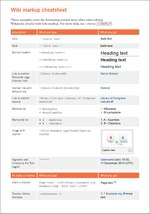KidzSearch Encyclopedia:Article wizard/Example

Wiki markup quick reference (PDF download)
This page shows you an example of how a Simple English Wikipedia article is written. In the two sections below, the top box (shaded grey) is the code as it appears in the edit box. The box underneath it shows what that code will produce.
In particular, this example will show you:
- How to add inline references, using the <ref></ref> tags
- How to add links to other articles, inside [[...]] brackets
- How to add links to other websites, such as [http://example.com/ this]
- How to format font, such as italics (''italics'') and bold text ('''bold text''')
- How to add section headers, with == Section ==
- How to add images; for more help on this, see Help:How to use images
The cheat sheet is a quick, easy reference on how to do these things properly. Another guide is available as a PDF download (see image right).
Code
[[File:Saturn during Equinox.jpg|thumb|260px|A picture of Saturn]]
'''Saturn''' is the sixth [[planet]] from the [[Sun]] in the [[Solar System]]. It is the second largest planet in the Solar System, after [[Jupiter]]. Like Jupiter, [[Uranus]] and [[Neptune]], it is a "[[gas giant]]". The inside of Saturn is probably a [[planetary core|core]] of [[iron]], [[nickel]], [[silicon]] and [[oxygen]] compounds, surrounded by a deep layer of [[metallic hydrogen]], then a layer of [[liquid]] [[hydrogen]] and liquid [[helium]] and finally, an outer [[gas]]eous layer.<ref name="Composition ref">{{cite web|url=http://www.astrophysicsspectator.com/topics/planets/GiantGaseousPlanets.html|title=Giant gaseous planets|accessdate=5 July 2010|last=Brainerd|first=Jerome James|date=27 October 2004|publisher=The Astrophysics Spectator}}</ref>
Saturn has 62 known [[Satellite (natural)|moons]] [[orbit]]ing the planet; 53 are officially named.<ref>{{cite web
|first=Enrico|last=Piazza|title=Saturn's moons|editor=Kirk Munsell|work=Cassini, Equinox Mission|publisher=JPL NASA|url=http://saturn.jpl.nasa.gov/science/moons/|accessdate=2010-06-22}}</ref> The largest moon is [[Titan (moon)|Titan]], which is larger in volume than the planet [[Mercury (planet)|Mercury]]. Titan is the second-largest moon in the Solar System. The largest moon is Jupiter's moon, [[Ganymede]]. Also around Saturn there is a very large system of [[planetary ring|rings]], made of [[ice]] with smaller amounts of [[minerals|rocks]] and dust. Saturn is about 1,400,000,000 [[kilometer|km]] (869,000,000 [[mile|mi]]) from the Sun. In the time it takes Saturn to complete one orbit of the Sun, or one Saturn year, the Earth has orbited 29.6 times, or 29.6 [[Julian year (astronomy)|years]] on Earth.<ref name="fact">Williams, Dr. David R. (7 September 2006) [http://nssdc.gsfc.nasa.gov/planetary/factsheet/saturnfact.html Saturn Earth comparison] ''Saturn fact sheet''. National Aeronautics and Space Administration.</ref>
Saturn was named after the [[Roman mythology|Roman god]] [[Saturn (mythology)|Saturnus]] (called [[Kronos]] in [[Greek mythology]]).<ref>{{cite web |url= http://www.credoreference.com/entry/hfcwd/cronia_kronia |title=Cronia (Kronia) |first= |last= |work=Holidays, Festivals, and Celebrations of the World Dictionary |year=2010 |accessdate=2011-07-11}}</ref> Saturn's symbol is ♄ which is the symbol of Saturnus' [[sickle]].<ref>Crystal, Ellie. [http://www.crystalinks.com/saturnmyth.html Saturn Mythology] ''Crystalinks.com''. Accessed 28 February 2007.</ref>
== Physical features ==
Saturn is an [[oblate spheroid]], meaning that it is flattened at the [[Geographical pole|pole]]s, and it swells out around its [[equator]]. The planet's equatorial [[diameter]] is {{convert|120536|km|mi|0|lk=off|abbr=on}}, while its polar diameter (the distance from the north pole to the south pole) is {{convert|108728|km|mi|0|lk=off|abbr=on}}; a 9% difference.<ref>[http://www.jpl.nasa.gov/news/press_kits/cassini-arrival.pdf Cassini–Huygens Saturn arrival] (PDF) ''Press kit June 2004''. National Aeronautics and Space Administration. p 9. Accessed 25 June 2011.</ref> Saturn has a flattened shape; it is due to its very fast [[rotation]], rotating once every 10.8 hours.<ref name="fact"/> Saturn is the only planet in the Solar System that is less [[density|dense]] than [[water]]. Even though the planet's [[planetary core|core]] is very dense, it has a gaseous [[atmosphere]], so the average [[relative density|specific density]] of the planet is 0.69 g/cm³ (less than the density of water). This means if Saturn could be placed in a large pool of water, it would float.<ref>Verba, Joan Marie (1991) "Voyager: Exploring the outer planets". FTL Publications. p 20. ISBN 0982523203.</ref>
=== Atmosphere ===
The outer part of Saturn's atmosphere is made up of about 96% hydrogen, 3% helium, 0.4% [[methane]] and 0.01% [[ammonia]].<ref name="fact"/> There are also very small amounts of [[acetylene]], [[ethane]] and [[phosphine]].<ref name="Mira">[http://www.mira.org/fts0/planets/100/text/txt002x.htm Saturn] ''MIRA: field trips to the stars: the Solar System''. 2006. Monterey Institute of Research in Astronomy. Accessed 19 June 2011.</ref>
== References ==
{{Reflist}}
== Other websites ==
* [http://nssdc.gsfc.nasa.gov/planetary/factsheet/saturnfact.html Saturn Earth comparison]
|
